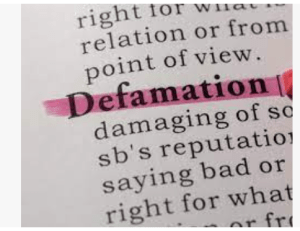The explosion of Fake News spread among social media sites is destroying a plaintiff’s ability to succeed in a defamation action. The recent proliferation of rushed journalism, online conspiracy theories, and the belief that most stories are, in fact, “Fake News” have created a desert of veracity. Widespread public skepticism about even the most mainstream social media reporting means plaintiffs need help convincing jurors that third parties believed any reported statement to be true. Such proof is necessary for a plaintiff to prove the elements of defamation.

Fake News Today
Fake News is any journalistic story that knowingly and intentionallyincludes untrue factual statements. Today, many speak of Fake News as a noun. There is no shortage of examples of Fake News and its impact.
-
-
- Pizzagate: During the 2016 Presidential Election, Edgar Madison Welch, 28, read a story on (then) Facebook that Hilary Clinton was running a child trafficking ring out of the basement of a pizzeria. Welch, a self-described vigilante, shot open a locked door of the pizzeria with his AR-15.
- A study by three MIT scholars found that false news stories spread faster on Twitter than true stories, with the former being 70% more likely to be retweeted than the latter.
- During the defamation trial of Amber Heard and Johnny Depp, a considerable number of “Fake News” reports circulated across social media platforms, particularly TikTok, Twitter, and YouTube, attacking Ms. Heard at a disproportionality more significant rate than Mr. Depp.
-

What is Defamation?
To establish defamation, a plaintiff must show the defendant published a false assertion of fact that damages the plaintiff’s reputation. Hyperbolic language or other indications that a statement was not meant to be taken seriously are not actionable. Today’s understanding that everything on the Internet is susceptible to manipulation destroys defamation.
Because the factuality of a statement is a question of law, a plaintiff must first convince a judge that the offending statement is fact and not opinion. Courts often find that Internet and social media statements are hyperbole or opinion. If a plaintiff succeeds in persuading the judge, then the issue of whether the statement defamed the plaintiff heads to the jury. A jury faced with defamation must determine whether the statement of fact harmed the defendant’s reputation or livelihood to the extent that it caused the plaintiff to incur damages. The prevalence of Fake News creates another layer of difficulty for the Internet plaintiff, who must convince the jury that the statement was true.
Defamation’s Slow and Steady Erosion
Since the 1960s, the judiciary has limited plaintiffs’ ability to succeed in defamation claims. The decisions in Sullivan v. New York Times and Gertz increased the difficulty for public figures, and those with limited public figure status, to succeed by requiring them to prove actual malice against a defendant, a standard higher than the mere negligence standard allowed for individuals who are not of community interest.
The rise of Internet use, mainly social media, presents plaintiffs with yet another hurdle. Plaintiffs can only succeed if the challenged statement is fact, not opinion. However, judges find that statements made on the Internet are opinions and not points. The combined effect of Supreme Court limitations on proof and the increased belief that social media posts are mostly opinions has limited the plaintiff’s ability to succeed in a defamation claim.

Destroying Defamation
If the Supreme Court and social media have eroded defamation, Fake News has destroyed it. Today, convincing a jury that a false statement purporting to be fact has defamed a plaintiff is difficult given the dual issues of society’s objective mistrust of the media and the understanding that information on the Internet is generally opinion, not fact. Fake News sows confusion and makes it almost impossible for jurors to believe any statement has the credibility necessary to cause harm.
To be clear, in some instances, fake News is so intolerable that a jury will find for the plaintiffs. A Connecticut jury found conspiracy theorist Alex Jones liable for defamation based on his assertion that the government had faked the Sandy Hook shootings.
But often, plaintiffs are unsuccessful where the challenged language is conflated with untruths. Fox News successfully defended itself against a lawsuit claiming that it had aired false and deceptive content about the coronavirus, even though its reporting was, in fact, untrue.
Similarly, a federal judge dismissed a defamation case against Fox News for Tucker Carlson’s report that the plaintiff had extorted then-President Donald Trump. In reaching its conclusion, the judge observed that Carlson’s comments were rhetorical hyperbole and that the reasonable viewer “‘arrive[s] with the appropriate amount of skepticism.”‘ Reports of media success in defending against defamation claims further fuel media mistrust.
The current polarization caused by identity politics is furthering the tendency for Americans to mistrust the media. Sarah Palin announced that the goal of her recent defamation case against The New York Times was to reveal that the “lamestream media” publishes “fake news.”
If jurors believe that no reasonable person could credit a challenged statement as accurate, they cannot find that the statement the plaintiff asserts is defamatory caused harm. An essential element of defamation is that the defendant’s remarks damaged the plaintiff’s reputation. The large number of people who believe News is fake, the media’s rush to publish, and external attacks on credible journalism have created a problematization of truth among members of society. The potential for defamatory harm is minimal when every news story is questionable. Ultimately, the presence of Fake News is a blight on the tort of defamation and, like the credibility of present-day news organizations, will erode it to the point of irrelevance.
Is there any hope for a world without Fake News?

